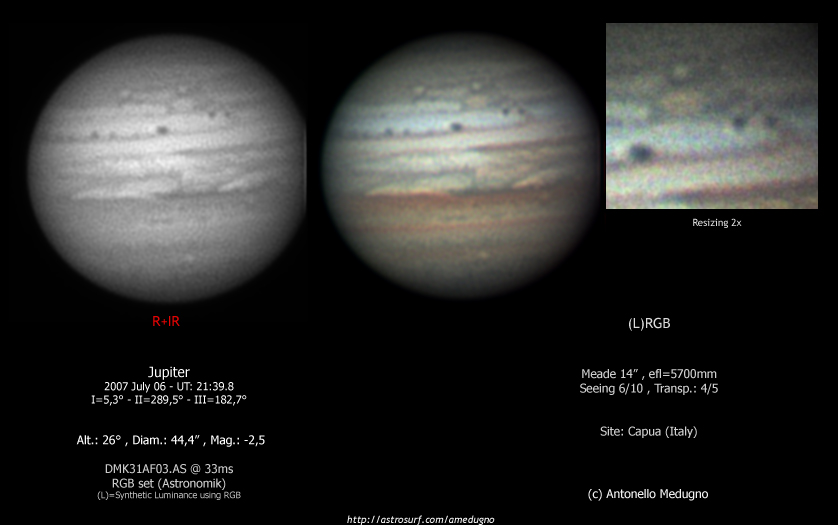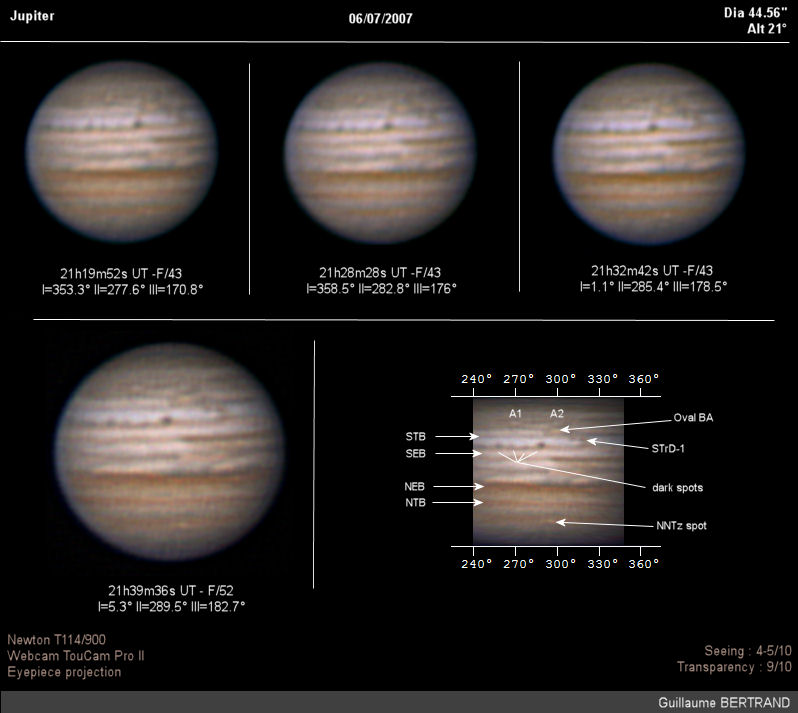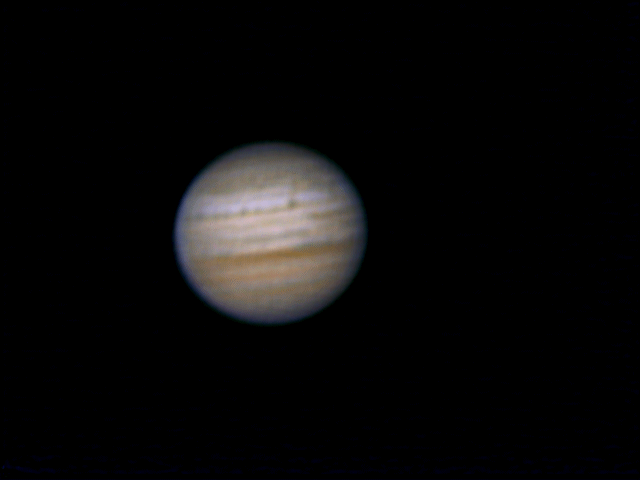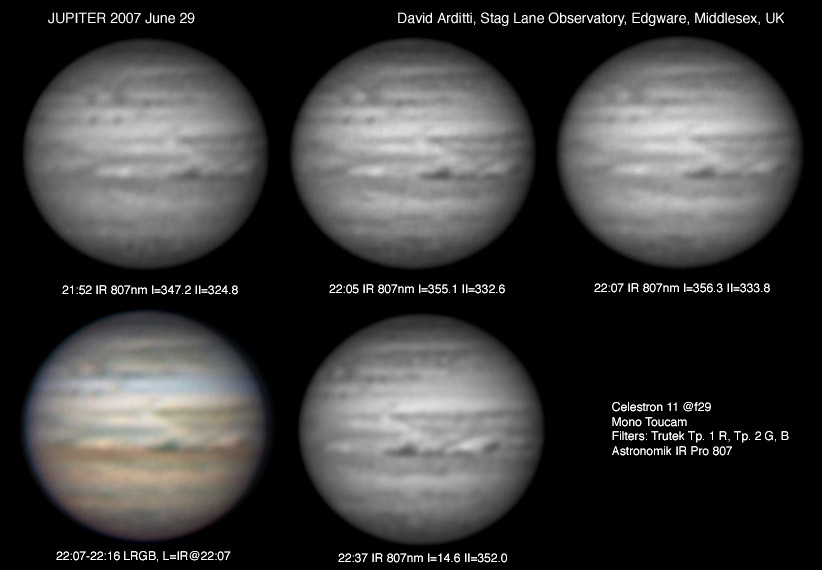木星 ALPO-Japan Latest

Jupiter Image 2007/07/06(UT)
Antonello Medugno,Guillaume Bertrand,Marc Delcroix,David Arditti
A.Medugno,G.Bertrand,M.Delcroix,D.Arditti
|
Antonello Medugno (356mm SC) |
2007/07/06 - UT: 21:39.8
Meade 14" (356mm) LX200 GPS (SC) efl=5700
Filters: G & B (Astronomik) R+IR Wratten #25 (Baader)
Camera: ImagingSource DMK31AF03.AS mono @ 33ms
Seeing 6/10,Trans.: 4/5
 [Antonello Medugno,Capua-Italy]
[Antonello Medugno,Capua-Italy]
|
Guillaume Bertrand (Newton 114mm) |
Here's some pictures of Jupiter,taken last night.
The transparency was very good but the seeing was poor.
I am rather satisfied by the result considering the aperture
of my telescope and the low altitude of Jupiter this year
in France (max 22°)
Images shows the chain of dark spots forming the SEB
retrograding towards STrD-1. STrD-1 is very prominent
since the interaction with the first dark spot.
Note the nice red NTB and a small white spot in the NNTz.

 [Guillaume Bertrand,France]
[Guillaume Bertrand,France]
The IR image has clearly better resolution than the other images and show
the 2 dark spots in STrD-1 and all of the chain of spots preceding the
disturbance.

[Marc Delcroix Tournefeuille,France]
|
David Arditti (250mm Dall-Kirkham Cassegrain) |
Here are the first results from a new DMK 21AF04.AS camera used on a C11. The
results are clearly a step above what I was getting from the mono Toucan under
similar conditions, and I hope to be able to compare the performance of this
camera with a Lumenera as well, soon. It needs to be emphasised that seeing
during this session was extremely poor, much less good than when I last imaged
Jupiter on June 29.
The southern portion of the globe contains oval BA, South Tropical Disturbance
II, and the chain of dark spots being generated by the ongoing SEB revival on
the S portion of the SEB. Of most interest is the comparison of these images
with the ones I took on June 29. I enclose these again for convenience. It
seems, taking these in combination with John Rogers commentary on the other
images sent to him recently, that they show the circulating current that has
swept one spot retrograding on the SEBs round the STrD, and started it
prograding on the STBn just following oval BA. From what he says, this would
appear to be the first observation of this phenomenon from the UK since 1934,
and the first time it has ever been imaged from the UK.
Antonello Medugno in Italy took a fine image 20 minutes earlier, showing the
same view more clearly:

 This makes it clear that the spot I have imaged in the STBn is the first of
those I imaged on the SEBs on June 29 (closest to the STrD II on that date), and
that the second one, following on closely, was in the STrD II at the time I
imaged on July 06, so is not resolved separately. These are the spots that have
been designated a and b respectively by Rogers. The big black spot in the SEBs I
have imaged just p oval BA is the result of the merger of his spots e and d,
which were right on the limb in my June 29 image, but then not fully merged.
Smaller spot c was imaged inbetween on that date.
Other interesting features of these images are the very straight reddish band of
the NTB, and spots in the NPR.
[David Arditti: Edgware Middlesex HA8 5LW: United Kingdom]
This makes it clear that the spot I have imaged in the STBn is the first of
those I imaged on the SEBs on June 29 (closest to the STrD II on that date), and
that the second one, following on closely, was in the STrD II at the time I
imaged on July 06, so is not resolved separately. These are the spots that have
been designated a and b respectively by Rogers. The big black spot in the SEBs I
have imaged just p oval BA is the result of the merger of his spots e and d,
which were right on the limb in my June 29 image, but then not fully merged.
Smaller spot c was imaged inbetween on that date.
Other interesting features of these images are the very straight reddish band of
the NTB, and spots in the NPR.
[David Arditti: Edgware Middlesex HA8 5LW: United Kingdom]


[Antonello Medugno,Capua-Italy]

[Guillaume Bertrand,France]


This makes it clear that the spot I have imaged in the STBn is the first of those I imaged on the SEBs on June 29 (closest to the STrD II on that date), and that the second one, following on closely, was in the STrD II at the time I imaged on July 06, so is not resolved separately. These are the spots that have been designated a and b respectively by Rogers. The big black spot in the SEBs I have imaged just p oval BA is the result of the merger of his spots e and d, which were right on the limb in my June 29 image, but then not fully merged. Smaller spot c was imaged inbetween on that date. Other interesting features of these images are the very straight reddish band of the NTB, and spots in the NPR. [David Arditti: Edgware Middlesex HA8 5LW: United Kingdom]
 ALPO-Japan Latest
ALPO-Japan Latest

 Jupiter Section
Jupiter Section